For a lot of students it is like in the film L'Auberge Espagnole. Recently, the benchmark of the 3 millionth Erasmus student was reached. This exchange programme, adopted in 1987, represents the first time living and studying abroad for many European students. Probably, it changed the life of most of them. From 2007 to 2013 it formed a major part of the EU Lifelong Learning Programme. On December 2013, the European Parliament approved the new form of the project, now called Erasmus+.
As reported on the Twitter bio of @EUErasmusPlus, the new seven year programme strengthens education, training, youth and sport in Europe, allowing young people (over 4 million Europeans according the forecasts) to gain experience by studying, training or volunteering abroad. It will have a significant budget of €14.7 billion, that represents a remarkable increase of 40% compared to current spending levels. At least 63% of this budget will concern Learning mobility of individuals. At least 28% of the money will be spent to improve the Cooperation for innovation and the exchange of good practices. Finally, the Support for policy reform will use the 4.2% of the funds.
By bringing together seven existing EU programmes, Erasmus+ will provide grants for individuals, but also support partnerships between several European institutions and organizations. In particular, the aim in the field of sport is to combat match-fixing, doping, violence and racism. All the details are available in the Erasmus+ Programme Guide, valid as of 1st January 2014. This document is addressed to stakeholders, students, trainees, apprentices, pupils, adult learners, young people, volunteers and professors.
Open access and multilingualism will be surely two main cornerstones of Erasmus+. Materials, documents and media that are useful for learning, teaching, training and youth work will be completely accessible. Furthermore, the European Union has set the goal that every citizen should have the opportunity to acquire at least two foreign languages from an early age, promoting in the same time the inclusion in the European labor market.
According to the forecasts, 2 million higher education students will be involved in Erasmus+ until 2020. A total of 500,000 young people will volunteer or participate in youth exchanges. Furthermore, 650,000 vocational apprenticeships or traineeships abroad are also expected. Finally, 800,000 educators and youth workers will acquire new teaching and learning methods abroad.
On 16th January 2014, a new and improved Erasmus+ site will be available, but several national agencies are already listed as Erasmus+ partners. For instance, as of 18th December 2013, three Italian institutions were participating: (1) Agenzia Nazionale LLP - ISFOL; (2) Agenzia Nazionale LLP - INDIRE; (3) Agenzia Nazionale per i Giovani. As reported by Dennis Abbott, EU spokesperson on education, an international experience abroad can really improve people's skills and their employability. Until 2020 more than 4 million people will take this opportunity to change their life.


